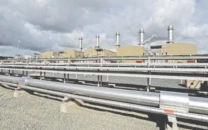Rise and fall of Pakistan's agriculture
Maize output shrank by 15%, while rice production slipped as well.

Just a year ago, agriculture was hailed as the "saviour" of Pakistan's economy. The sector recorded an impressive growth rate of 6.25% - the best in two decades — and well above that of other sectors. Rural incomes rose, exports expanded and confidence was high. The Finance Minister proudly celebrated the resilience of farmers and the strength of the agriculture sector.
In just one year, the situation has dramatically changed. Agricultural growth has collapsed and in the second quarter of fiscal year 2024-25, output increased by only 1.1%. The main factor was a significant fall in the output of Pakistan's major crops. Cotton production, crucial for the textiles industry which is the country's largest export earner, dropped by over 30%.
Maize output shrank by 15%, while rice production slipped as well. The risk of food insecurity also looms large as the outlook for wheat, the country's most important food crop, is dire. Forecasts suggest a production shortfall of about 11%, driven by less area under cultivation, dry weather conditions and policy uncertainty.
Lower agriculture growth implies that farm incomes are under pressure but there are also knock-on effects. Reduced agricultural output hurts the entire economy: fewer exports mean less foreign exchange; smaller wheat harvests mean higher food prices; and rural hardship translates into more pressure on social services and increased rural to urban migration.
What caused this sudden reversal, and more importantly, what must we do to get agriculture back on track?
A major factor for the poor performance was unfavourable weather. Low rainfall, drought-like conditions and erratic temperatures impacted crop yields. Water scarcity was severe and, more critically, are likely to continue. Both Tarbela and Mangla dams — Pakistan's largest reservoirs — are now at, or near, dead levels and farmers in Sindh and Punjab are facing severe irrigation shortages. Tensions with India over water flows under the Indus Waters Treaty add a layer of political risk to an already fragile situation.
Whatever the outcome of the dispute with India, and whatever happens to climate in the coming years, water scarcity will likely remain an existential threat for Pakistani agriculture. In the meantime, we continue to waste water through poor irrigation practices and planting water guzzling crops. Without urgent action, the next few years could see even more frequent and more damaging agricultural failures.
Policy missteps have made a bad situation worse. The government's decision to withdraw from the wheat market and remove the traditional minimum support price was a correct one. The system was costly, inefficient and corrupt — simply unsustainable. However, change was maybe done too rapidly without adequate preparation and the withdrawal of Government support sent shockwaves through the wheat production and marketing system.
This change came on the footsteps of past mistakes. For example in 2023, Government projections suggested surplus wheat production and Pakistan exported wheat. However, these projections turned out to be wrong, domestic supply was insufficient, and we had to resort to costly imports to meet food requirements.
However, amidst the gloom, there are some encouraging signs. A new wave of young, educated entrepreneurs is bringing technology to the fields. Startups are offering services like soil sampling and tailored fertiliser advice, allowing farmers to optimise input use and reduce costs. Apps now provide real-time market price information, helping farmers negotiate better deals.
Some entrepreneurs are leasing large tracts of land and running them professionally, using techniques such as laser land leveling, precision planting, efficient irrigation systems and mechanised harvesting. Their results are remarkable: doubling or even tripling farm incomes compared to traditional methods. Livestock farming is seeing similar gains. Where a traditional cow might yield just a few liters of milk per day, well-fed, vaccinated and properly housed animals can produce five times as much. The potential is there. But these innovations remain the exception, not the rule — and most small farmers still lack the financing, training and market access needed to make the leap.
If Pakistan is serious about safeguarding its food future and revitalising rural economies, bold action is needed now.
To put agriculture back on a sustainable path, five key priorities must be urgently addressed.
First, water management needs a complete overhaul. This means promoting efficient irrigation technologies like drip and sprinkler systems and revising outdated water pricing policies to reflect scarcity and encourage conservation. Second, land use planning must be enforced to stop the widespread conversion of fertile farmland into housing colonies.
Zoning regulations should be strengthened to protect agricultural zones. Third, agricultural research and extension services must broaden their scope. The current obsession with seed development should be complemented with a serious focus on soil health, post-harvest storage, water management and strengthening value chains. Fourth, farmers — especially smallholders — need better access to credit, but this support should be smartly targeted. Subsidies and financing should be tied to performance and good practices rather than distributed blindly.
Finally, decision-making in the sector must become data-driven. Advanced tools like remote sensing, satellite monitoring and AI-based forecasting should be used to monitor crop health, predict yields and manage risk. Guesswork and reactive policymaking must be replaced with proactive, evidence-based planning.
In formulating a programme for action, the private sector, farmers' organisations and civil society must be treated as full partners — not just passive recipients of top-down government directives. History shows that crises can be opportunities for real change. The collapse of agricultural growth is a wake-up call — not just for policymakers, but for society as a whole.
Agriculture still employs over a third of Pakistan's workforce. It is the foundation of our food security and a key driver of rural stability. Getting agriculture right is not a luxury; it is a necessity. And if the right actions are taken today, this crisis could spark off the transformation.



1729685382-0/Untitled-design-(57)1729685382-0-208x130.webp)










COMMENTS (1)
Comments are moderated and generally will be posted if they are on-topic and not abusive.
For more information, please see our Comments FAQ